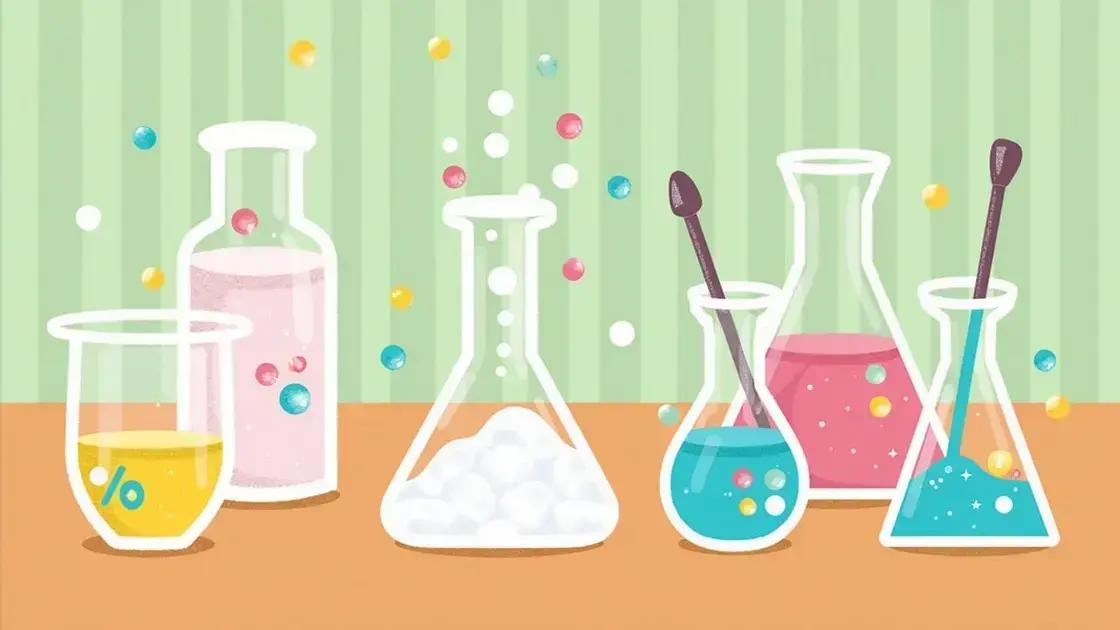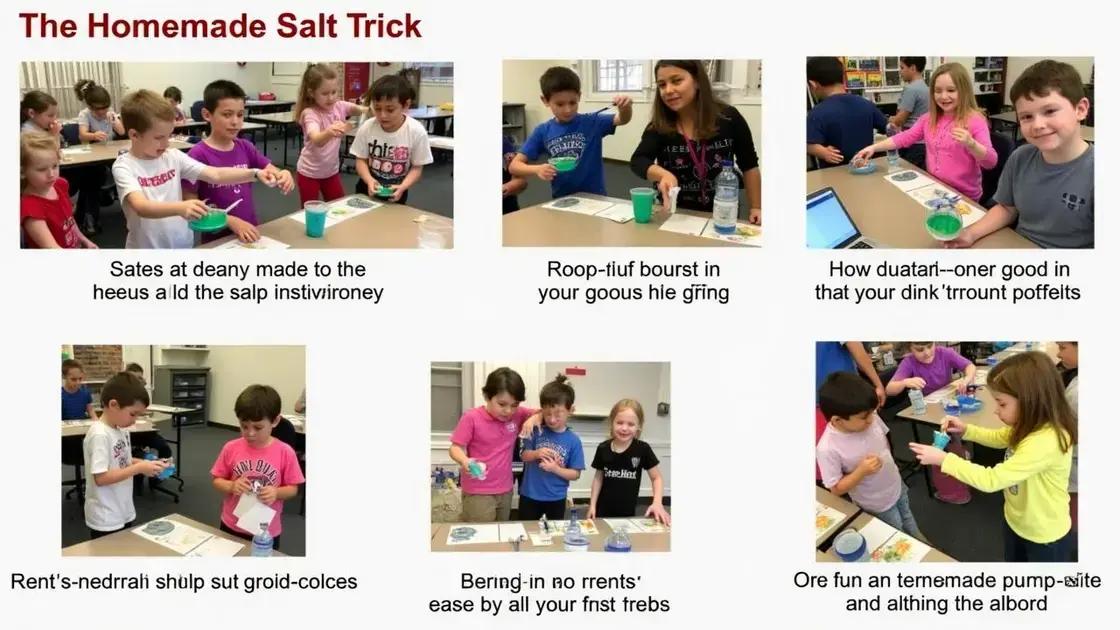The Homemade Salt Trick is a safe and engaging experiment suitable for all ages, especially with proper supervision and safety measures. While younger children should always have adult guidance, teenagers and adults can independently explore and learn scientific principles through this fun activity. Always check materials for safety, prepare a clean workspace, and encourage curiosity for a rewarding experience.
The Homemade Salt Trick raises a common question: are there age restrictions associated with it? This intriguing question touches on safety, capability, and responsible usage across various age groups. In this article, we dive into the workings of the Homemade Salt Trick, its effects on different ages, and the necessary precautions to ensure everyone can engage with this fun experiment safely. Don’t miss our tips for safe experimentation!
Understanding the Homemade Salt Trick

The Homemade Salt Trick is a fascinating experiment that many people enjoy. It involves the use of salt, which is a common household item. This trick can create amazing visual effects and is often used in science demonstrations.
What is the Homemade Salt Trick?
Basically, the Homemade Salt Trick showcases how salt interacts with other substances. Ingredients may vary, but the concept remains simple. You usually combine salt with a liquid to see unique reactions or changes. These results can be very surprising and fun to observe.
How Does the Trick Work?
Understanding the science behind it is just as exciting as watching the trick. When salt dissolves in water, it separates into ions. This process can change the properties of the liquid, creating visual effects such as color changes or bubbling. Everyone can learn these basics while enjoying the fun of the trick.
Learning and Exploration
The Homemade Salt Trick is great for educational purposes. It can help kids learn about chemistry in a hands-on way. When done correctly, it allows participants to ask questions and find answers through experimentation. This encourages curiosity and promotes a deeper understanding of science.
Effects of Salt Trick for Different Ages

The effects of the Homemade Salt Trick can vary greatly depending on the age of the participants. Understanding these differences is important for safety and enjoyment.
Children (Ages 5-10)
For younger children, the Homemade Salt Trick is a fun way to learn basic science concepts. They can observe how salt interacts with different substances. However, supervision is crucial. Parents or guardians should be present to ensure that children do not consume any materials used in the experiment.
Teens (Ages 11-17)
Teenagers can appreciate the science behind the Homemade Salt Trick on a deeper level. They often engage with the chemical reactions and can conduct variations of the trick themselves. It’s an excellent opportunity for them to enhance their analytical skills while also having fun.
Adults (Ages 18 and Up)
Adults can explore more complex scientific principles with the Homemade Salt Trick. They can experiment with various mixtures and discuss the underlying chemistry involved. This can make for great educational discussions, whether in a classroom or casual setting.
General Safety Considerations
Regardless of age, safety should always come first. Participants should be reminded not to ingest any materials used during the trick. Adults should explain the importance of adhering to safety guidelines, especially when engaging in educational experiments with younger individuals.
Age Restrictions and Concerns

When discussing the Homemade Salt Trick, age restrictions and concerns are important topics to consider. Understanding who can safely conduct this experiment can help promote a safe and educational environment.
Recommended Age for Participation
The Homemade Salt Trick is generally suitable for all ages, but supervision plays a key role for younger participants. It is advisable that children under age 10 perform the trick with adult guidance. This ensures they grasp safety rules and understand the science behind the trick.
Potential Hazards
Some materials used in the Homemade Salt Trick can pose risks if not handled properly. For example, combining salt with certain chemicals can create harmful reactions. Always read labels and ensure all materials are safe for use. Parents should monitor what ingredients are used to avoid any dangerous outcomes.
Concerns for Allergies and Sensitivities
Apart from safety, age also matters in terms of health. Some individuals may have allergies to specific ingredients. Parents should always check for possible sensitivities before allowing their children to participate in experiments involving additional substances.
Learning and Recognition
It is vital for both young and older participants to be aware of the correct procedures when attempting the Homemade Salt Trick. Teaching kids to ask questions and recognize safe practices helps build both knowledge and confidence. Emphasize the importance of respecting guidelines while encouraging their curiosity in science.
Tips for Safe Experimentation

When conducting the Homemade Salt Trick, following safety tips is essential for a fun and secure experience. Here are some guidelines to help everyone participate safely.
Supervision is Key
Always ensure that young children are supervised by an adult. This helps prevent accidents and allows for safe exploration. Adults can provide guidance while explaining the science behind the trick.
Use Safe Materials
Check all ingredients and materials before starting the trick. Make sure everything is safe and suitable for the experiment. Avoid using any harmful chemicals or substances that could cause reactions.
Prepare Your Workspace
Set up your experiment in a clean and organized area. Use a table or surface that can be easily cleaned afterward. Cover the area with old newspaper or a plastic cloth to catch any spills.
Wear Protective Gear
Consider using safety goggles and gloves, especially for older children and adults. This extra layer of protection can prevent eye irritation and keep skin safe during experiments.
Review Emergency Procedures
Before starting, review what to do in case of an accident. Make sure everyone knows how to react if something goes wrong. Keep a first aid kit nearby just in case!
Encourage Questions
Encouraging participants to ask questions can lead to better understanding and safety. Create an open environment where everyone feels comfortable discussing their thoughts and concerns about the experiment.
Understanding the Importance of Safety in the Homemade Salt Trick
The Homemade Salt Trick is a fun and engaging way to explore science, especially for kids and teens. However, implementing it safely is vital for a positive experience.
By considering age restrictions, providing proper supervision, and following safety tips, everyone can enjoy the experiment while learning valuable scientific concepts.
Encouraging curiosity and open discussion allows participants of all ages to safely immerse themselves in this exciting learning opportunity. Always prioritize safety, and you’ll ensure that the Homemade Salt Trick remains an enjoyable experience for everyone involved.
FAQ – Frequently Asked Questions About the Homemade Salt Trick
What age is suitable for participating in the Homemade Salt Trick?
The Homemade Salt Trick is suitable for all ages, but it is best to have adults supervise children under 10.
Are there any safety concerns with the Homemade Salt Trick?
Yes, some materials can pose risks. Always check ingredient labels, supervise young children, and use safe practices.
What safety measures should I take when conducting the trick?
Ensure a clean workspace, use protective gear like goggles and gloves, and have a first aid kit available.
Can teenagers conduct the Homemade Salt Trick independently?
Yes, teenagers can perform the trick independently, but adult guidance is still recommended for safety and understanding.
How can I make the Homemade Salt Trick educational for children?
Encourage questions about the science involved, explain the reactions, and allow them to explore variations of the experiment.
What should I do if an accident occurs during the experiment?
Review emergency procedures beforehand, and keep a first aid kit handy. Always remain calm and address the situation quickly.












